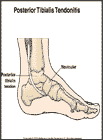
Posterior Tibial Tendonitis
What is posterior tibial tendonitis?
Posterior tibial tendonitis causes pain along the inner side of the lower leg, ankle or foot. Tendons are strong bands of connective tissue which attach muscles to bones. The posterior tibial tendon helps point the foot down and in. Tendonitis is inflammation of a tendon.
How does it occur?
Posterior tibial tendonitis occurs from overuse of the tendon. This tendon attaches to a bone in the foot called the navicular and helps stabilize your arch. If your arch flattens out more than normal when you walk or run it is called over-pronation. When you over-pronate you strain your tendon and are more likely to get posterior tibial tendonitis.
What are the symptoms?
Symptoms include:
- pain or tenderness on the inner side of the shin, ankle or foot
- pain with lifting up your foot
- pain walking or running.
How is it diagnosed?
Your health care provider will review your symptoms and examine your leg, ankle and foot. Your foot will be tender along the tendon and where it attaches to the navicular bone. You may be asked to walk or run to see if you over-pronate.
How is it treated?
Treatment may include:
- Applying ice packs to your foot for 20 to 30 minutes every 3 to 4 hours for the first 2 to 3 days or until the pain goes away. Thereafter, ice your foot at least once a day until the other symptoms are gone.
- Doing ice massage. Freeze water in a cup and then peel back the top of the cup. Massage the ice into the painful tendon for 5 to 10 minutes.
- Elevating your lower leg and foot by placing a pillow underneath it. Try to keep your foot above the level of your heart.
- Your provider may recommend special arch supports or inserts for you shoes called orthotics, either custom-made or off the shelf.
- Taping your foot to give extra support to your arch, the navicular bone and the attachment of the posterior tibial tendon.
- Sometimes a cast is needed for a few weeks until the pain and inflammation go away.
- Using crutches until you can walk without pain.
- Taking anti-inflammatory medication or other pain medication prescribed by your provider.
- Doing exercises to improve your tendon strength and flexibility. The exercises will help you return to your normal activity or sports.
When can I return to my sport or activity?
The goal of rehabilitation is to return you to your sport or activity as soon as is safely possible. If you return too soon you may worsen your injury, which could lead to long-term damage. Everyone recovers from injury at a different rate. Return to your sport or activity will be determined by how soon your injured tendon recovers, not by how many days or weeks it has been since your injury occurred. In general, the longer you have symptoms before you start treatment, the longer it will take to get better.
You may safely return to your sport or activity when, starting from the top of the list and progressing to the end, each of the following is true:
- You have full range of motion in the injured leg and foot compared to the uninjured leg and foot.
- You have full strength of the injured leg and foot compared to the uninjured leg and foot.
- You can jog straight ahead without pain or limping.
- You can sprint straight ahead without pain or limping.
- You can do 45-degree cuts, first at half-speed, then at full-speed.
- You can do 20-yard figures-of-eight, first at half-speed, then at full-speed.
- You can do 90-degree cuts, first at half-speed, then at full-speed.
- You can do 10-yard figures-of-eight first at half-speed, then at full-speed.
- You can jump on both legs without pain and you can jump on the injured leg without pain.

